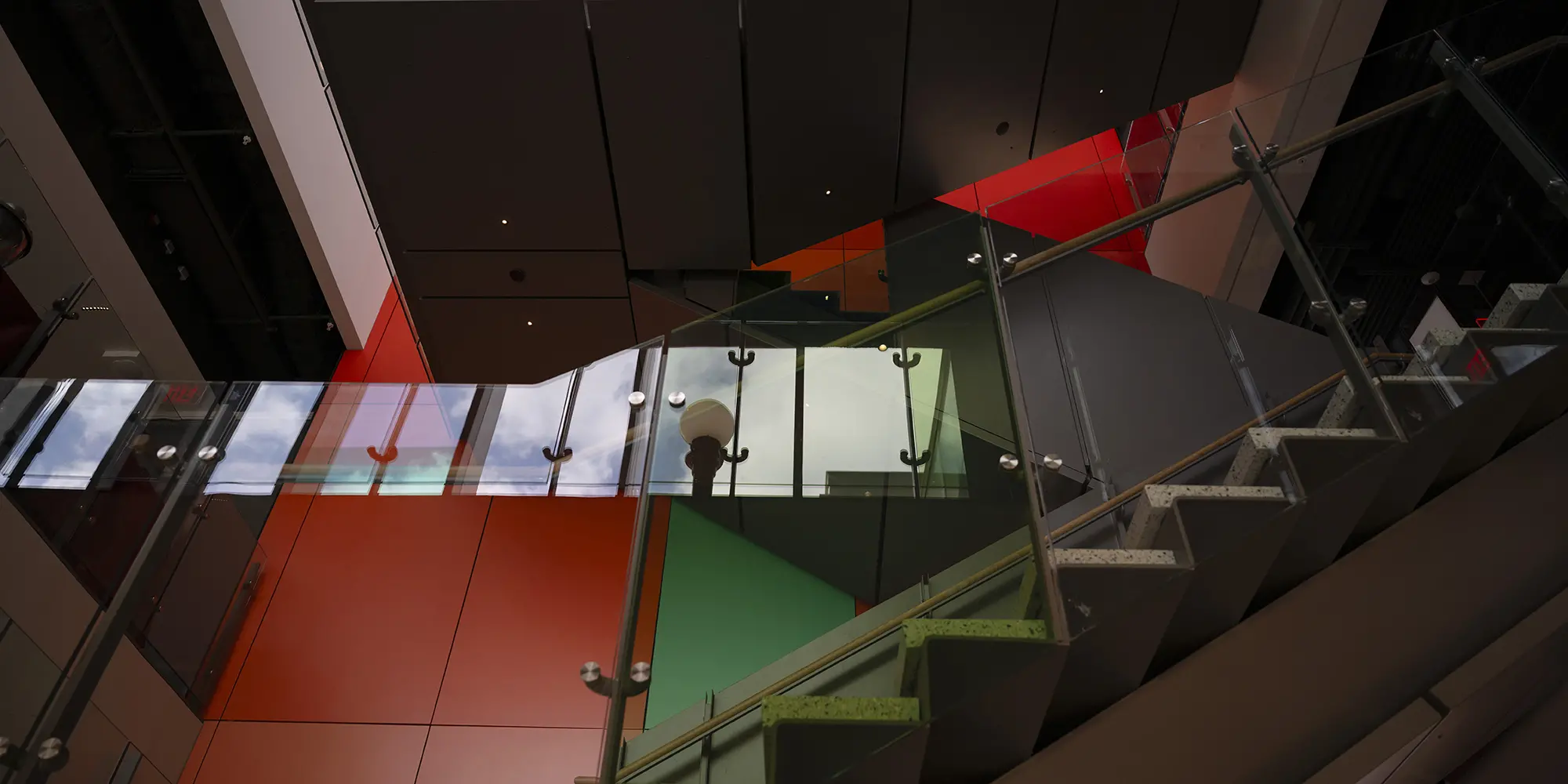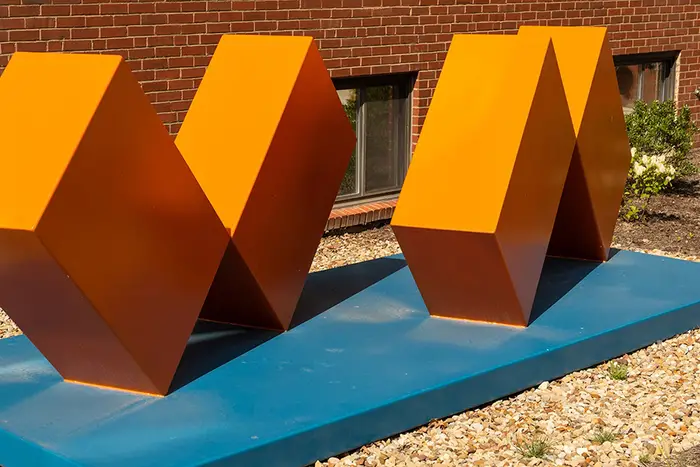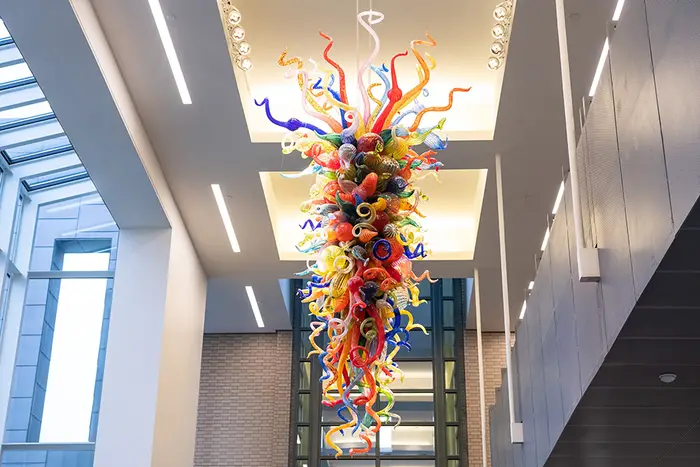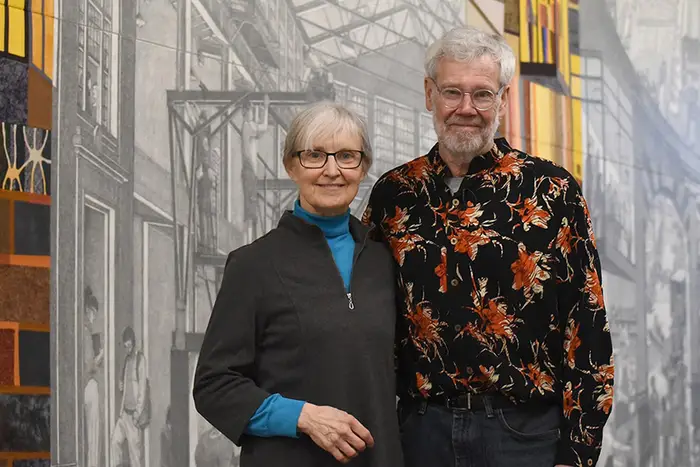


Art Meets Engineering in New Scaife Hall
“Making Way” by Jessica Stockholder is CMU’s latest public art installation
Media Inquiries
Visitors to Carnegie Mellon University’s new Alan Magee Scaife Hall, home to its Department of Mechanical Engineering(opens in new window), will be greeted by a new piece of public art amid the building’s classrooms, labs, offices and collaborative spaces.
“Making Way” by Jessica Stockholder will enthrall some visitors by disrupting their perceptions of physical building confines through its use of vibrant colors, translucency, light and familiar objects that intersect structural elements. For others, the experience will be subtler: The creative process was heavily influenced by an intentional vision to fully integrate art into Scaife Hall’s design and construction, as well as a highly collaborative partnership between Stockholder and its architects, Kieran Timberlake.
“I hope that the work is there to engage people in their own ways,” said Stockholder, a professor in the Department of Visual Arts at the University of Chicago. “I imagine that some people won’t even notice the work, and some will spend a lot of time with it. It will be a different experience for those who work in the building, who cohabitate with it throughout the seasons. I look forward to hearing from people, especially people who live with the work over time.”
In her artist’s statement, Stockholder offered this description, “The artwork sits both inside and outside, supported and contained by the building’s structure and the landscape design. The artwork does not stay within the lines. It slips in and out of the forms established by the site and opens up a space for imagining the many pathways open to us within any structure or system.”
Before entering Scaife Hall, visitors will experience a highway-scale light pole and bollards that have been transformed with unexpected colors. Additional altered light poles greet visitors inside on the ground floor, including one that cuts through three of the building’s floors. The lamps cast their own light but also interact with the shifting light from the sun. Visitors then encounter translucent-colored films that rest on top of the exterior glass, modifying the view inside and outside the building while also casting different colors onto the building’s surfaces. The four-story wall behind the grand stairwell, surfaced with various oranges, pinks, reds and greens, together with some colored glass panels in the guardrails, interact with all that comes before.
“My piece kind of wafts through the building. It proposes boundaries that are distinct from those established by the architecture; the two hover together,” Stockholder said. “That experience — a noticing of one set of assumptions, an intersection, a blur between different conventions — can act as a metaphor for an openness in thinking processes.”
An internationally acclaimed artist, Stockholder has received numerous awards, including a Guggenheim Fellowship and the Lucelia Artist Award from the Smithsonian American Art Museum. In 2018 she was elected to the American Academy of Arts & Sciences. Her work is in the permanent collections of numerous museums, including the Whitney Museum of Art, New York; The Art Institute of Chicago; MoCA LA; SF MoMA; the Museum of Fine Arts, Boston; The British Museum, London; and the Stedelijk Museum, Amsterdam.
Since 2013, Carnegie Mellon has committed to incorporating public art in all new building construction as part of the Simonds Commission’s principles. A member of the CMU’s Public Art Commission since her arrival on campus in 2017 as director of the Miller Institute for Contemporary Art, Elizabeth Chodos was appointed in 2022 to lead the commission as the university’s public art curator. In that role, she leads a holistic process that begins with understanding a new building’s site and design, and continues through development of criteria, identification of the artist, partnership with Campus Design and Facility Development and the architects, and ultimately installation of the work.
Recently completed projects include “Good Thoughts, Good Words, Good Deeds,”(opens in new window) a 44-foot long, 8-foot tall mural by artist Stephanie Dinkins that captures the attention of visitors to TCS Hall, completed in 2022, as well as “Inverted Dancer,”(opens in new window) a gravity-defying bronze sculpture by Pittsburgh artist Thaddeus Mosley that is the centerpiece of the courtyard at Fifth and Clyde House.
For Chodos and the planning committee, Scaife Hall represented the university’s first opportunity to fully incorporate art into its design through a process that began early in the building’s development and allowed engagement with its future occupants.
“With Scaife Hall, one of the things that was really clear in meeting with the stakeholders of that project was the idea of breaking boundaries,” Chodos said. “The idea of thinking outside of the box, looking at problems from new vantage points to come up with solutions not thought of before. Thinking in new ways of old things. And also reinvention of everyday materials, putting multiple elements together to solve complex problems.”
She added, “When you change your perspective, you think of something from a totally different point of view, inspiring aha moments. Jessica’s work sits both outside and inside the building, on the surface of the windows. It tests the boundaries of where it begins and where it ends, thinking about how you can stretch beyond things that seem fixed. How color is both an object and a light and how it changes throughout the day. These are all questions that Jessica’s work is asking and I thought really resonated with the spirit of mechanical engineering, which is reimagining everything around you. That’s why I thought her work would really work with the building.”
For Chodos, Carnegie Mellon’s community and culture have uniquely empowered the completed “Making Way” and the overall commitment to public art.
“Provost Jim Garrett said to me that CMU is a place that makes amazing things possible that wouldn’t be possible otherwise,” she said. “I really feel like this public art program and this work of art couldn’t exist anywhere else. It took a lot of openness, a tolerance for doing something different and a vision. I’m really proud to be a part of this university to be able to accomplish this.”


